Strategic Analysis of Marks & Spencer: Case Study and Recommendations
VerifiedAdded on 2023/06/10
|11
|2358
|281
Report
AI Summary
This report provides a comprehensive strategic analysis of Marks & Spencer (M&S), examining its competitive environment and operational strategies. It begins with an introduction to the competitive landscape, highlighting the need for M&S to implement effective strategies. The report then conducts a PEST analysis, evaluating political, economic, social, and technological factors impacting the company, and applies Porter's Five Forces framework to assess the competitive intensity within the industry. The analysis further explores the external environment, including trends, opportunities, and threats. The report delves into M&S's internal capabilities through value chain analysis, identifying primary and support activities, core competencies, and the value created for customers. Strategic issues and problems affecting M&S are discussed, including slow decision-making and cultural misunderstandings in international markets. Finally, the report recommends strategic approaches such as differentiation and cost leadership, to enhance M&S's competitive advantage. The report concludes by referencing key academic sources that support the analysis and recommendations.
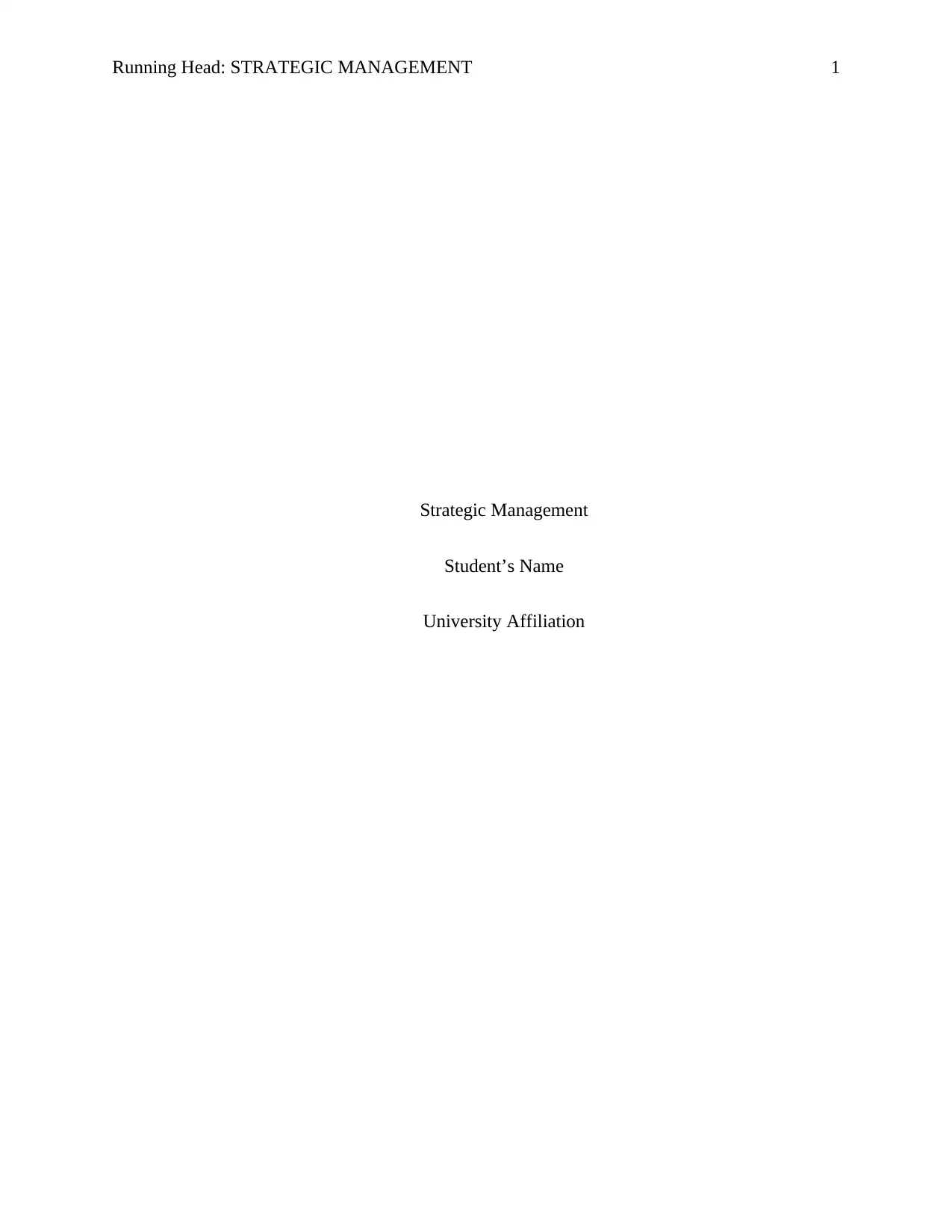
Running Head: STRATEGIC MANAGEMENT 1
Strategic Management
Student’s Name
University Affiliation
Strategic Management
Student’s Name
University Affiliation
Paraphrase This Document
Need a fresh take? Get an instant paraphrase of this document with our AI Paraphraser
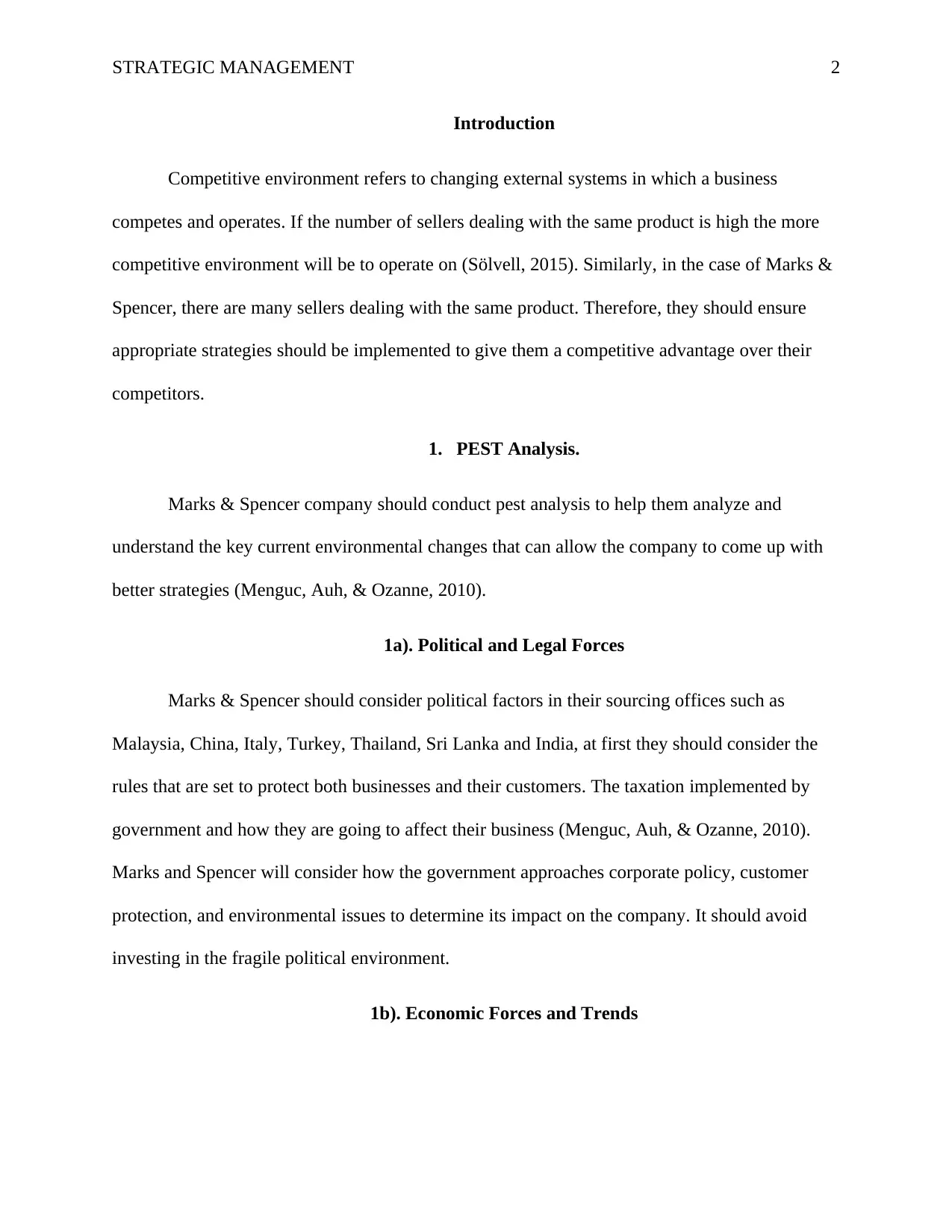
STRATEGIC MANAGEMENT 2
Introduction
Competitive environment refers to changing external systems in which a business
competes and operates. If the number of sellers dealing with the same product is high the more
competitive environment will be to operate on (Sölvell, 2015). Similarly, in the case of Marks &
Spencer, there are many sellers dealing with the same product. Therefore, they should ensure
appropriate strategies should be implemented to give them a competitive advantage over their
competitors.
1. PEST Analysis.
Marks & Spencer company should conduct pest analysis to help them analyze and
understand the key current environmental changes that can allow the company to come up with
better strategies (Menguc, Auh, & Ozanne, 2010).
1a). Political and Legal Forces
Marks & Spencer should consider political factors in their sourcing offices such as
Malaysia, China, Italy, Turkey, Thailand, Sri Lanka and India, at first they should consider the
rules that are set to protect both businesses and their customers. The taxation implemented by
government and how they are going to affect their business (Menguc, Auh, & Ozanne, 2010).
Marks and Spencer will consider how the government approaches corporate policy, customer
protection, and environmental issues to determine its impact on the company. It should avoid
investing in the fragile political environment.
1b). Economic Forces and Trends
Introduction
Competitive environment refers to changing external systems in which a business
competes and operates. If the number of sellers dealing with the same product is high the more
competitive environment will be to operate on (Sölvell, 2015). Similarly, in the case of Marks &
Spencer, there are many sellers dealing with the same product. Therefore, they should ensure
appropriate strategies should be implemented to give them a competitive advantage over their
competitors.
1. PEST Analysis.
Marks & Spencer company should conduct pest analysis to help them analyze and
understand the key current environmental changes that can allow the company to come up with
better strategies (Menguc, Auh, & Ozanne, 2010).
1a). Political and Legal Forces
Marks & Spencer should consider political factors in their sourcing offices such as
Malaysia, China, Italy, Turkey, Thailand, Sri Lanka and India, at first they should consider the
rules that are set to protect both businesses and their customers. The taxation implemented by
government and how they are going to affect their business (Menguc, Auh, & Ozanne, 2010).
Marks and Spencer will consider how the government approaches corporate policy, customer
protection, and environmental issues to determine its impact on the company. It should avoid
investing in the fragile political environment.
1b). Economic Forces and Trends
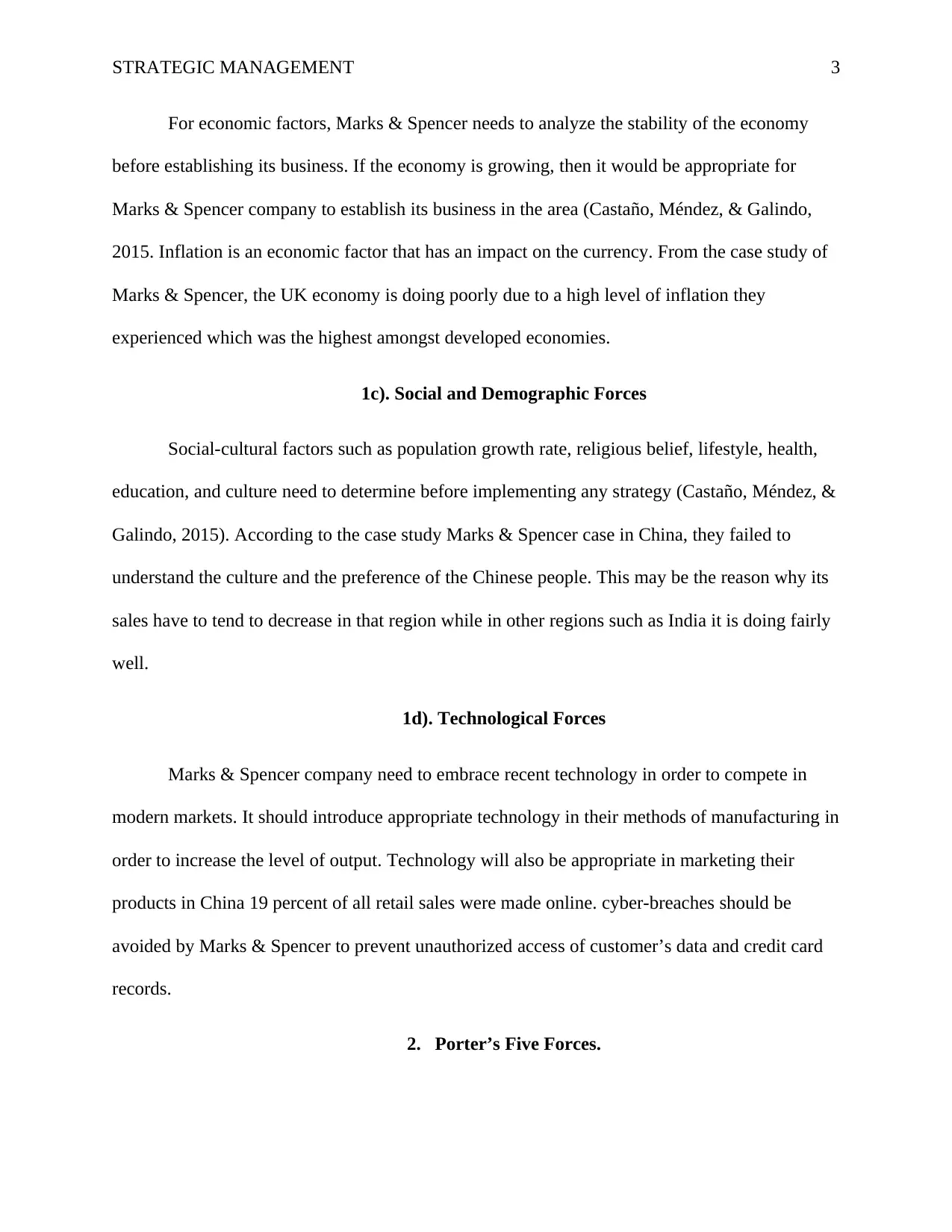
STRATEGIC MANAGEMENT 3
For economic factors, Marks & Spencer needs to analyze the stability of the economy
before establishing its business. If the economy is growing, then it would be appropriate for
Marks & Spencer company to establish its business in the area (Castaño, Méndez, & Galindo,
2015. Inflation is an economic factor that has an impact on the currency. From the case study of
Marks & Spencer, the UK economy is doing poorly due to a high level of inflation they
experienced which was the highest amongst developed economies.
1c). Social and Demographic Forces
Social-cultural factors such as population growth rate, religious belief, lifestyle, health,
education, and culture need to determine before implementing any strategy (Castaño, Méndez, &
Galindo, 2015). According to the case study Marks & Spencer case in China, they failed to
understand the culture and the preference of the Chinese people. This may be the reason why its
sales have to tend to decrease in that region while in other regions such as India it is doing fairly
well.
1d). Technological Forces
Marks & Spencer company need to embrace recent technology in order to compete in
modern markets. It should introduce appropriate technology in their methods of manufacturing in
order to increase the level of output. Technology will also be appropriate in marketing their
products in China 19 percent of all retail sales were made online. cyber-breaches should be
avoided by Marks & Spencer to prevent unauthorized access of customer’s data and credit card
records.
2. Porter’s Five Forces.
For economic factors, Marks & Spencer needs to analyze the stability of the economy
before establishing its business. If the economy is growing, then it would be appropriate for
Marks & Spencer company to establish its business in the area (Castaño, Méndez, & Galindo,
2015. Inflation is an economic factor that has an impact on the currency. From the case study of
Marks & Spencer, the UK economy is doing poorly due to a high level of inflation they
experienced which was the highest amongst developed economies.
1c). Social and Demographic Forces
Social-cultural factors such as population growth rate, religious belief, lifestyle, health,
education, and culture need to determine before implementing any strategy (Castaño, Méndez, &
Galindo, 2015). According to the case study Marks & Spencer case in China, they failed to
understand the culture and the preference of the Chinese people. This may be the reason why its
sales have to tend to decrease in that region while in other regions such as India it is doing fairly
well.
1d). Technological Forces
Marks & Spencer company need to embrace recent technology in order to compete in
modern markets. It should introduce appropriate technology in their methods of manufacturing in
order to increase the level of output. Technology will also be appropriate in marketing their
products in China 19 percent of all retail sales were made online. cyber-breaches should be
avoided by Marks & Spencer to prevent unauthorized access of customer’s data and credit card
records.
2. Porter’s Five Forces.
⊘ This is a preview!⊘
Do you want full access?
Subscribe today to unlock all pages.

Trusted by 1+ million students worldwide
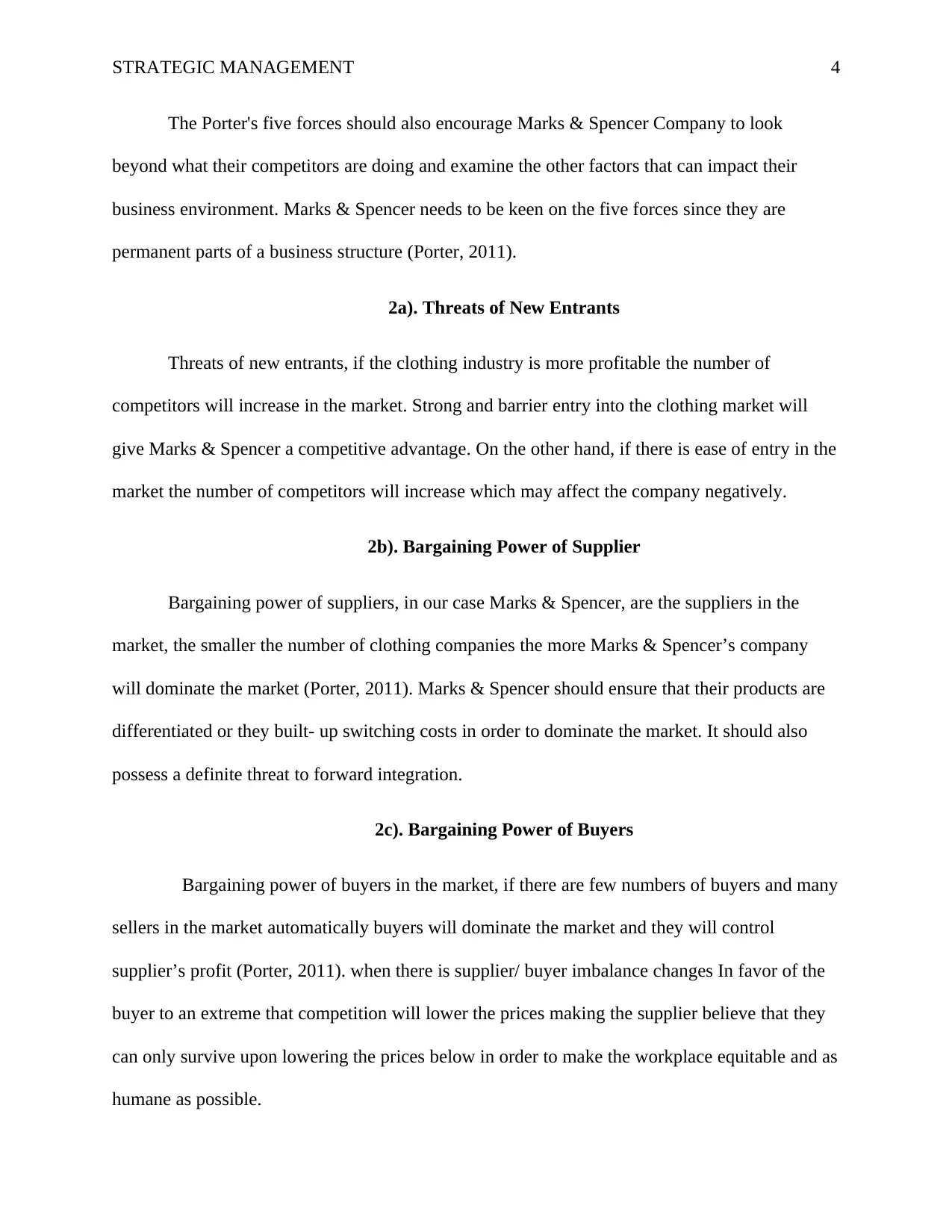
STRATEGIC MANAGEMENT 4
The Porter's five forces should also encourage Marks & Spencer Company to look
beyond what their competitors are doing and examine the other factors that can impact their
business environment. Marks & Spencer needs to be keen on the five forces since they are
permanent parts of a business structure (Porter, 2011).
2a). Threats of New Entrants
Threats of new entrants, if the clothing industry is more profitable the number of
competitors will increase in the market. Strong and barrier entry into the clothing market will
give Marks & Spencer a competitive advantage. On the other hand, if there is ease of entry in the
market the number of competitors will increase which may affect the company negatively.
2b). Bargaining Power of Supplier
Bargaining power of suppliers, in our case Marks & Spencer, are the suppliers in the
market, the smaller the number of clothing companies the more Marks & Spencer’s company
will dominate the market (Porter, 2011). Marks & Spencer should ensure that their products are
differentiated or they built- up switching costs in order to dominate the market. It should also
possess a definite threat to forward integration.
2c). Bargaining Power of Buyers
Bargaining power of buyers in the market, if there are few numbers of buyers and many
sellers in the market automatically buyers will dominate the market and they will control
supplier’s profit (Porter, 2011). when there is supplier/ buyer imbalance changes In favor of the
buyer to an extreme that competition will lower the prices making the supplier believe that they
can only survive upon lowering the prices below in order to make the workplace equitable and as
humane as possible.
The Porter's five forces should also encourage Marks & Spencer Company to look
beyond what their competitors are doing and examine the other factors that can impact their
business environment. Marks & Spencer needs to be keen on the five forces since they are
permanent parts of a business structure (Porter, 2011).
2a). Threats of New Entrants
Threats of new entrants, if the clothing industry is more profitable the number of
competitors will increase in the market. Strong and barrier entry into the clothing market will
give Marks & Spencer a competitive advantage. On the other hand, if there is ease of entry in the
market the number of competitors will increase which may affect the company negatively.
2b). Bargaining Power of Supplier
Bargaining power of suppliers, in our case Marks & Spencer, are the suppliers in the
market, the smaller the number of clothing companies the more Marks & Spencer’s company
will dominate the market (Porter, 2011). Marks & Spencer should ensure that their products are
differentiated or they built- up switching costs in order to dominate the market. It should also
possess a definite threat to forward integration.
2c). Bargaining Power of Buyers
Bargaining power of buyers in the market, if there are few numbers of buyers and many
sellers in the market automatically buyers will dominate the market and they will control
supplier’s profit (Porter, 2011). when there is supplier/ buyer imbalance changes In favor of the
buyer to an extreme that competition will lower the prices making the supplier believe that they
can only survive upon lowering the prices below in order to make the workplace equitable and as
humane as possible.
Paraphrase This Document
Need a fresh take? Get an instant paraphrase of this document with our AI Paraphraser
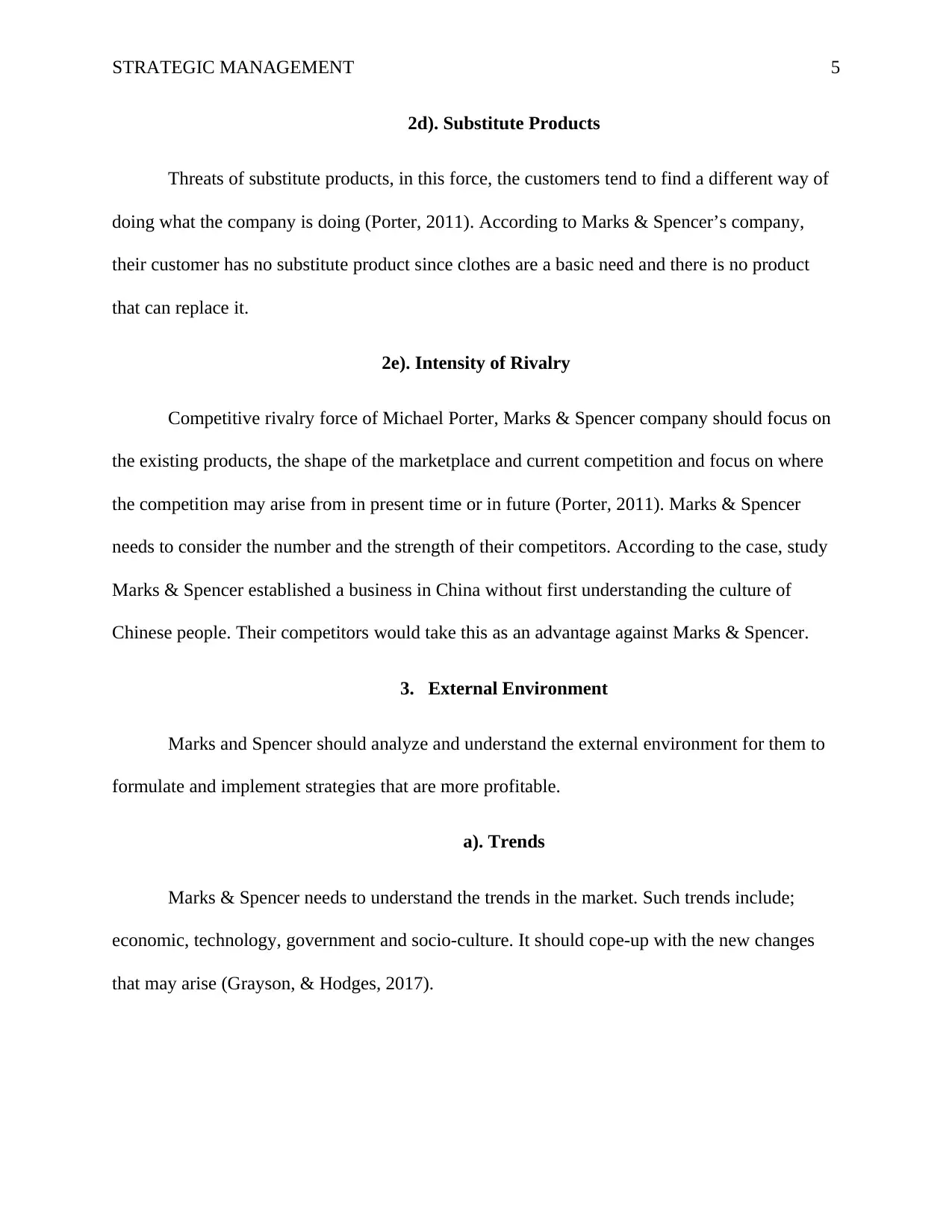
STRATEGIC MANAGEMENT 5
2d). Substitute Products
Threats of substitute products, in this force, the customers tend to find a different way of
doing what the company is doing (Porter, 2011). According to Marks & Spencer’s company,
their customer has no substitute product since clothes are a basic need and there is no product
that can replace it.
2e). Intensity of Rivalry
Competitive rivalry force of Michael Porter, Marks & Spencer company should focus on
the existing products, the shape of the marketplace and current competition and focus on where
the competition may arise from in present time or in future (Porter, 2011). Marks & Spencer
needs to consider the number and the strength of their competitors. According to the case, study
Marks & Spencer established a business in China without first understanding the culture of
Chinese people. Their competitors would take this as an advantage against Marks & Spencer.
3. External Environment
Marks and Spencer should analyze and understand the external environment for them to
formulate and implement strategies that are more profitable.
a). Trends
Marks & Spencer needs to understand the trends in the market. Such trends include;
economic, technology, government and socio-culture. It should cope-up with the new changes
that may arise (Grayson, & Hodges, 2017).
2d). Substitute Products
Threats of substitute products, in this force, the customers tend to find a different way of
doing what the company is doing (Porter, 2011). According to Marks & Spencer’s company,
their customer has no substitute product since clothes are a basic need and there is no product
that can replace it.
2e). Intensity of Rivalry
Competitive rivalry force of Michael Porter, Marks & Spencer company should focus on
the existing products, the shape of the marketplace and current competition and focus on where
the competition may arise from in present time or in future (Porter, 2011). Marks & Spencer
needs to consider the number and the strength of their competitors. According to the case, study
Marks & Spencer established a business in China without first understanding the culture of
Chinese people. Their competitors would take this as an advantage against Marks & Spencer.
3. External Environment
Marks and Spencer should analyze and understand the external environment for them to
formulate and implement strategies that are more profitable.
a). Trends
Marks & Spencer needs to understand the trends in the market. Such trends include;
economic, technology, government and socio-culture. It should cope-up with the new changes
that may arise (Grayson, & Hodges, 2017).
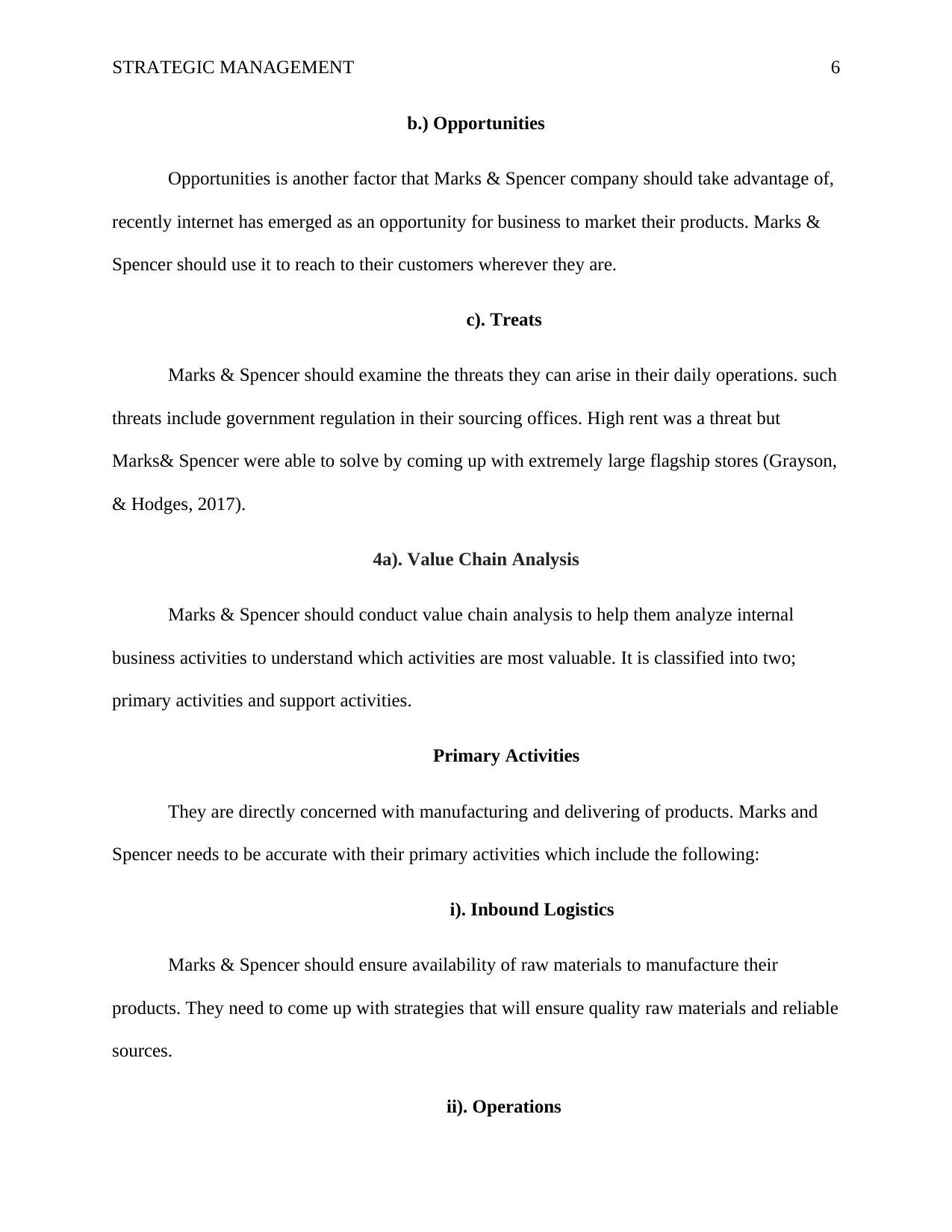
STRATEGIC MANAGEMENT 6
b.) Opportunities
Opportunities is another factor that Marks & Spencer company should take advantage of,
recently internet has emerged as an opportunity for business to market their products. Marks &
Spencer should use it to reach to their customers wherever they are.
c). Treats
Marks & Spencer should examine the threats they can arise in their daily operations. such
threats include government regulation in their sourcing offices. High rent was a threat but
Marks& Spencer were able to solve by coming up with extremely large flagship stores (Grayson,
& Hodges, 2017).
4a). Value Chain Analysis
Marks & Spencer should conduct value chain analysis to help them analyze internal
business activities to understand which activities are most valuable. It is classified into two;
primary activities and support activities.
Primary Activities
They are directly concerned with manufacturing and delivering of products. Marks and
Spencer needs to be accurate with their primary activities which include the following:
i). Inbound Logistics
Marks & Spencer should ensure availability of raw materials to manufacture their
products. They need to come up with strategies that will ensure quality raw materials and reliable
sources.
ii). Operations
b.) Opportunities
Opportunities is another factor that Marks & Spencer company should take advantage of,
recently internet has emerged as an opportunity for business to market their products. Marks &
Spencer should use it to reach to their customers wherever they are.
c). Treats
Marks & Spencer should examine the threats they can arise in their daily operations. such
threats include government regulation in their sourcing offices. High rent was a threat but
Marks& Spencer were able to solve by coming up with extremely large flagship stores (Grayson,
& Hodges, 2017).
4a). Value Chain Analysis
Marks & Spencer should conduct value chain analysis to help them analyze internal
business activities to understand which activities are most valuable. It is classified into two;
primary activities and support activities.
Primary Activities
They are directly concerned with manufacturing and delivering of products. Marks and
Spencer needs to be accurate with their primary activities which include the following:
i). Inbound Logistics
Marks & Spencer should ensure availability of raw materials to manufacture their
products. They need to come up with strategies that will ensure quality raw materials and reliable
sources.
ii). Operations
⊘ This is a preview!⊘
Do you want full access?
Subscribe today to unlock all pages.

Trusted by 1+ million students worldwide
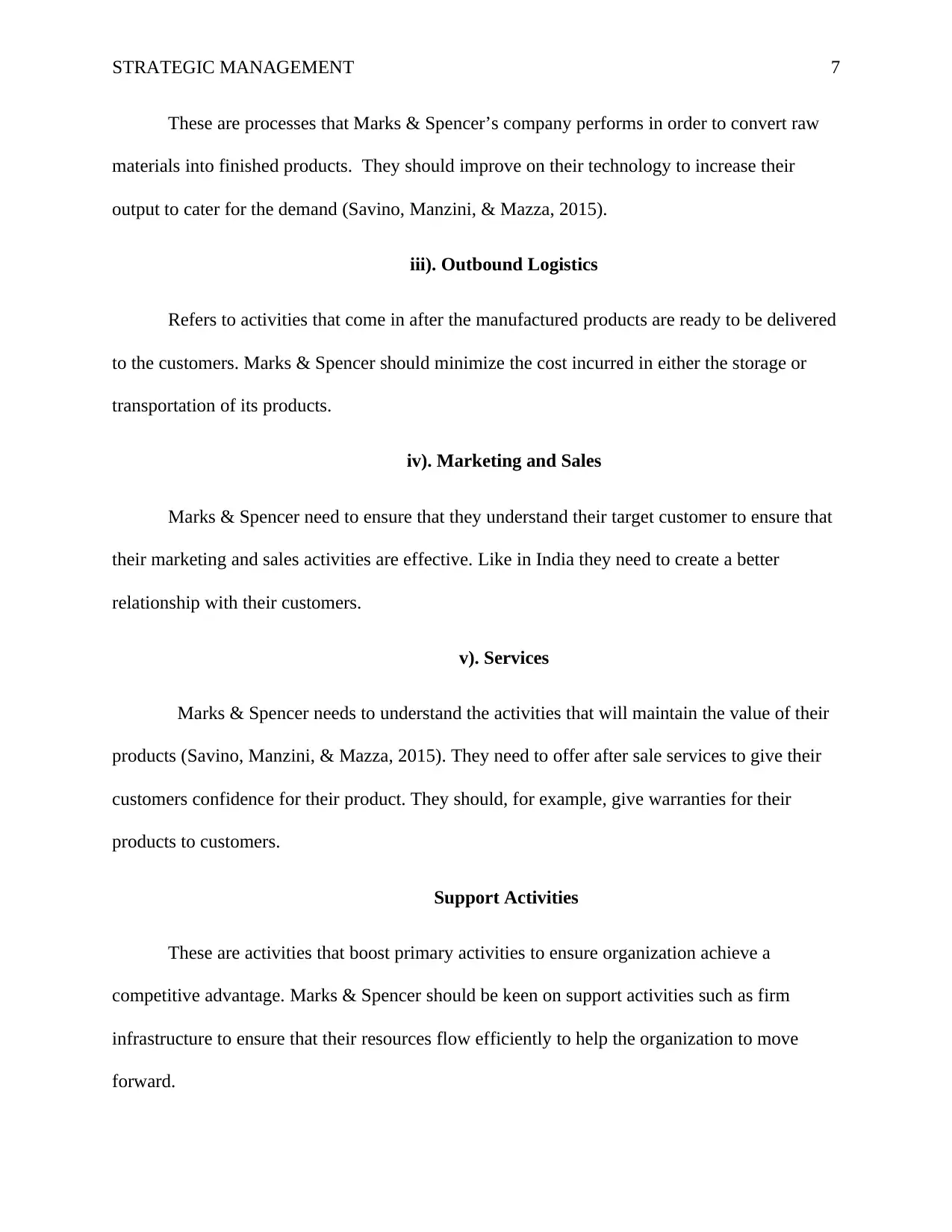
STRATEGIC MANAGEMENT 7
These are processes that Marks & Spencer’s company performs in order to convert raw
materials into finished products. They should improve on their technology to increase their
output to cater for the demand (Savino, Manzini, & Mazza, 2015).
iii). Outbound Logistics
Refers to activities that come in after the manufactured products are ready to be delivered
to the customers. Marks & Spencer should minimize the cost incurred in either the storage or
transportation of its products.
iv). Marketing and Sales
Marks & Spencer need to ensure that they understand their target customer to ensure that
their marketing and sales activities are effective. Like in India they need to create a better
relationship with their customers.
v). Services
Marks & Spencer needs to understand the activities that will maintain the value of their
products (Savino, Manzini, & Mazza, 2015). They need to offer after sale services to give their
customers confidence for their product. They should, for example, give warranties for their
products to customers.
Support Activities
These are activities that boost primary activities to ensure organization achieve a
competitive advantage. Marks & Spencer should be keen on support activities such as firm
infrastructure to ensure that their resources flow efficiently to help the organization to move
forward.
These are processes that Marks & Spencer’s company performs in order to convert raw
materials into finished products. They should improve on their technology to increase their
output to cater for the demand (Savino, Manzini, & Mazza, 2015).
iii). Outbound Logistics
Refers to activities that come in after the manufactured products are ready to be delivered
to the customers. Marks & Spencer should minimize the cost incurred in either the storage or
transportation of its products.
iv). Marketing and Sales
Marks & Spencer need to ensure that they understand their target customer to ensure that
their marketing and sales activities are effective. Like in India they need to create a better
relationship with their customers.
v). Services
Marks & Spencer needs to understand the activities that will maintain the value of their
products (Savino, Manzini, & Mazza, 2015). They need to offer after sale services to give their
customers confidence for their product. They should, for example, give warranties for their
products to customers.
Support Activities
These are activities that boost primary activities to ensure organization achieve a
competitive advantage. Marks & Spencer should be keen on support activities such as firm
infrastructure to ensure that their resources flow efficiently to help the organization to move
forward.
Paraphrase This Document
Need a fresh take? Get an instant paraphrase of this document with our AI Paraphraser
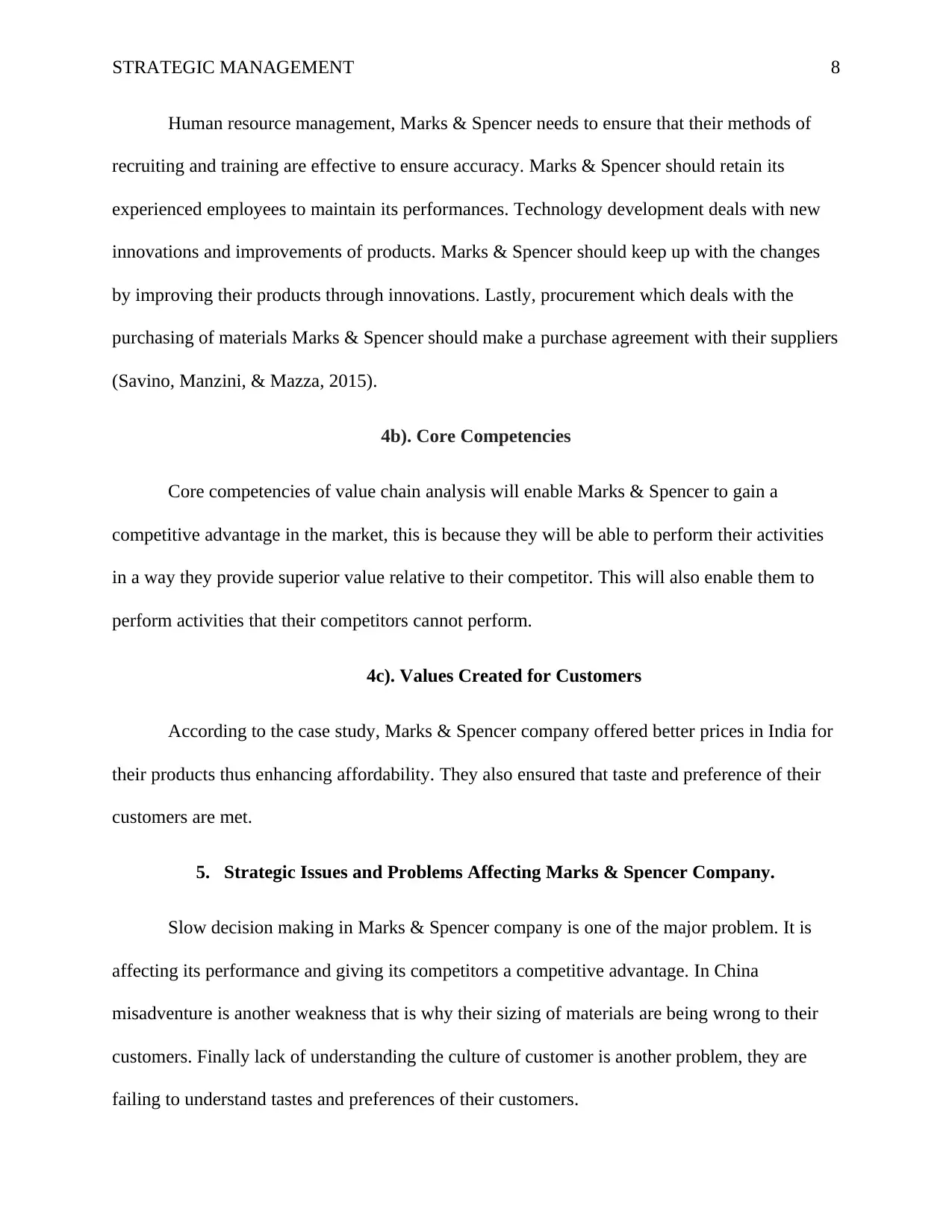
STRATEGIC MANAGEMENT 8
Human resource management, Marks & Spencer needs to ensure that their methods of
recruiting and training are effective to ensure accuracy. Marks & Spencer should retain its
experienced employees to maintain its performances. Technology development deals with new
innovations and improvements of products. Marks & Spencer should keep up with the changes
by improving their products through innovations. Lastly, procurement which deals with the
purchasing of materials Marks & Spencer should make a purchase agreement with their suppliers
(Savino, Manzini, & Mazza, 2015).
4b). Core Competencies
Core competencies of value chain analysis will enable Marks & Spencer to gain a
competitive advantage in the market, this is because they will be able to perform their activities
in a way they provide superior value relative to their competitor. This will also enable them to
perform activities that their competitors cannot perform.
4c). Values Created for Customers
According to the case study, Marks & Spencer company offered better prices in India for
their products thus enhancing affordability. They also ensured that taste and preference of their
customers are met.
5. Strategic Issues and Problems Affecting Marks & Spencer Company.
Slow decision making in Marks & Spencer company is one of the major problem. It is
affecting its performance and giving its competitors a competitive advantage. In China
misadventure is another weakness that is why their sizing of materials are being wrong to their
customers. Finally lack of understanding the culture of customer is another problem, they are
failing to understand tastes and preferences of their customers.
Human resource management, Marks & Spencer needs to ensure that their methods of
recruiting and training are effective to ensure accuracy. Marks & Spencer should retain its
experienced employees to maintain its performances. Technology development deals with new
innovations and improvements of products. Marks & Spencer should keep up with the changes
by improving their products through innovations. Lastly, procurement which deals with the
purchasing of materials Marks & Spencer should make a purchase agreement with their suppliers
(Savino, Manzini, & Mazza, 2015).
4b). Core Competencies
Core competencies of value chain analysis will enable Marks & Spencer to gain a
competitive advantage in the market, this is because they will be able to perform their activities
in a way they provide superior value relative to their competitor. This will also enable them to
perform activities that their competitors cannot perform.
4c). Values Created for Customers
According to the case study, Marks & Spencer company offered better prices in India for
their products thus enhancing affordability. They also ensured that taste and preference of their
customers are met.
5. Strategic Issues and Problems Affecting Marks & Spencer Company.
Slow decision making in Marks & Spencer company is one of the major problem. It is
affecting its performance and giving its competitors a competitive advantage. In China
misadventure is another weakness that is why their sizing of materials are being wrong to their
customers. Finally lack of understanding the culture of customer is another problem, they are
failing to understand tastes and preferences of their customers.
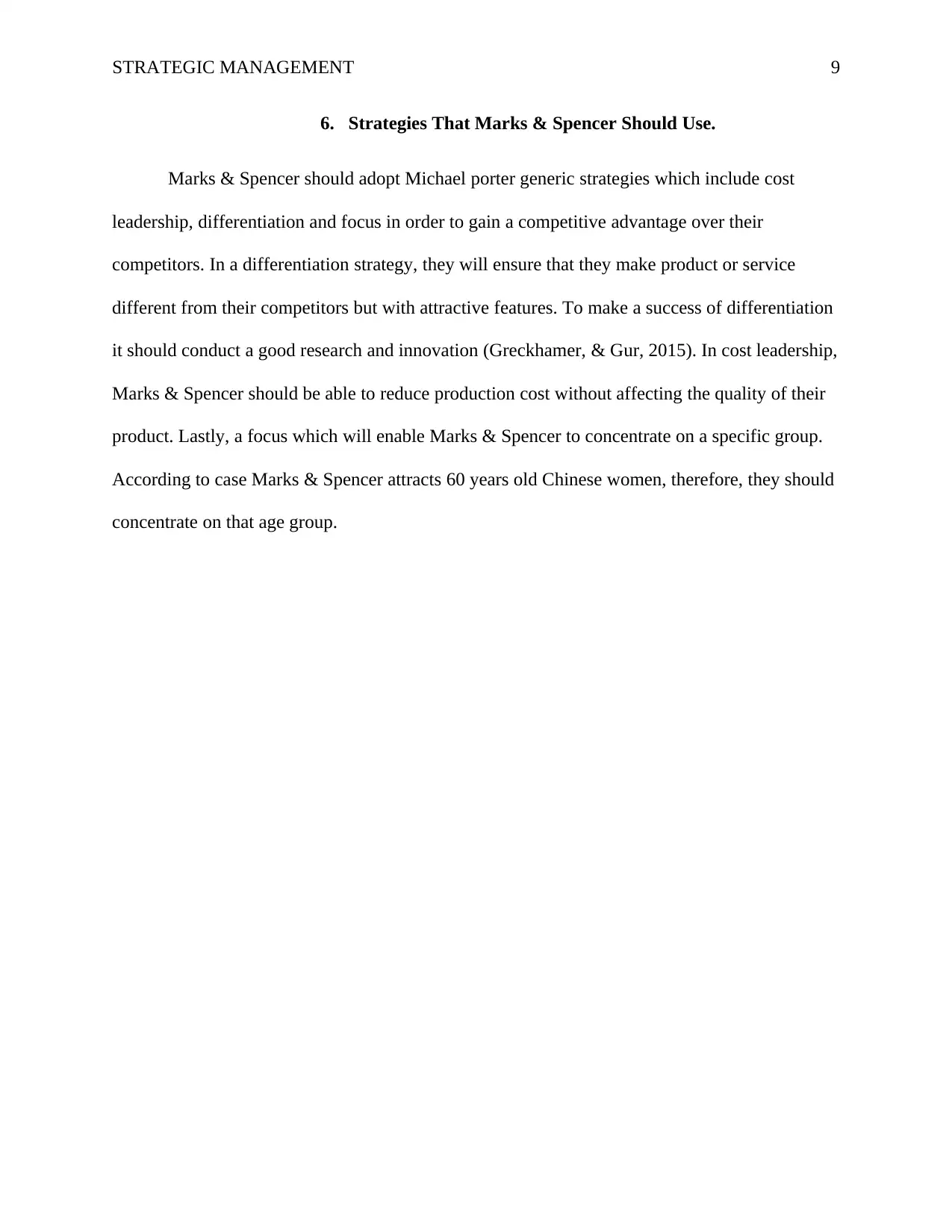
STRATEGIC MANAGEMENT 9
6. Strategies That Marks & Spencer Should Use.
Marks & Spencer should adopt Michael porter generic strategies which include cost
leadership, differentiation and focus in order to gain a competitive advantage over their
competitors. In a differentiation strategy, they will ensure that they make product or service
different from their competitors but with attractive features. To make a success of differentiation
it should conduct a good research and innovation (Greckhamer, & Gur, 2015). In cost leadership,
Marks & Spencer should be able to reduce production cost without affecting the quality of their
product. Lastly, a focus which will enable Marks & Spencer to concentrate on a specific group.
According to case Marks & Spencer attracts 60 years old Chinese women, therefore, they should
concentrate on that age group.
6. Strategies That Marks & Spencer Should Use.
Marks & Spencer should adopt Michael porter generic strategies which include cost
leadership, differentiation and focus in order to gain a competitive advantage over their
competitors. In a differentiation strategy, they will ensure that they make product or service
different from their competitors but with attractive features. To make a success of differentiation
it should conduct a good research and innovation (Greckhamer, & Gur, 2015). In cost leadership,
Marks & Spencer should be able to reduce production cost without affecting the quality of their
product. Lastly, a focus which will enable Marks & Spencer to concentrate on a specific group.
According to case Marks & Spencer attracts 60 years old Chinese women, therefore, they should
concentrate on that age group.
⊘ This is a preview!⊘
Do you want full access?
Subscribe today to unlock all pages.

Trusted by 1+ million students worldwide
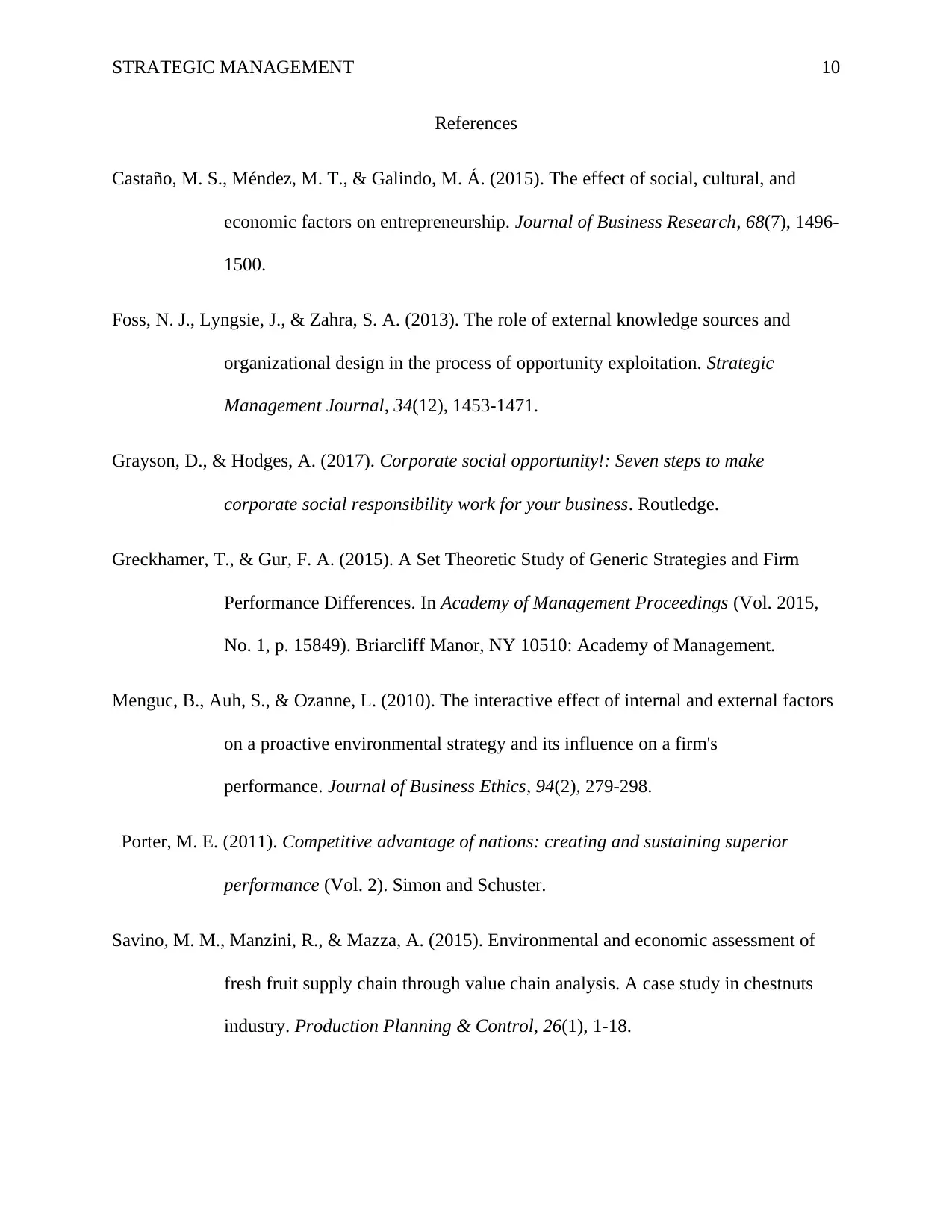
STRATEGIC MANAGEMENT 10
References
Castaño, M. S., Méndez, M. T., & Galindo, M. Á. (2015). The effect of social, cultural, and
economic factors on entrepreneurship. Journal of Business Research, 68(7), 1496-
1500.
Foss, N. J., Lyngsie, J., & Zahra, S. A. (2013). The role of external knowledge sources and
organizational design in the process of opportunity exploitation. Strategic
Management Journal, 34(12), 1453-1471.
Grayson, D., & Hodges, A. (2017). Corporate social opportunity!: Seven steps to make
corporate social responsibility work for your business. Routledge.
Greckhamer, T., & Gur, F. A. (2015). A Set Theoretic Study of Generic Strategies and Firm
Performance Differences. In Academy of Management Proceedings (Vol. 2015,
No. 1, p. 15849). Briarcliff Manor, NY 10510: Academy of Management.
Menguc, B., Auh, S., & Ozanne, L. (2010). The interactive effect of internal and external factors
on a proactive environmental strategy and its influence on a firm's
performance. Journal of Business Ethics, 94(2), 279-298.
Porter, M. E. (2011). Competitive advantage of nations: creating and sustaining superior
performance (Vol. 2). Simon and Schuster.
Savino, M. M., Manzini, R., & Mazza, A. (2015). Environmental and economic assessment of
fresh fruit supply chain through value chain analysis. A case study in chestnuts
industry. Production Planning & Control, 26(1), 1-18.
References
Castaño, M. S., Méndez, M. T., & Galindo, M. Á. (2015). The effect of social, cultural, and
economic factors on entrepreneurship. Journal of Business Research, 68(7), 1496-
1500.
Foss, N. J., Lyngsie, J., & Zahra, S. A. (2013). The role of external knowledge sources and
organizational design in the process of opportunity exploitation. Strategic
Management Journal, 34(12), 1453-1471.
Grayson, D., & Hodges, A. (2017). Corporate social opportunity!: Seven steps to make
corporate social responsibility work for your business. Routledge.
Greckhamer, T., & Gur, F. A. (2015). A Set Theoretic Study of Generic Strategies and Firm
Performance Differences. In Academy of Management Proceedings (Vol. 2015,
No. 1, p. 15849). Briarcliff Manor, NY 10510: Academy of Management.
Menguc, B., Auh, S., & Ozanne, L. (2010). The interactive effect of internal and external factors
on a proactive environmental strategy and its influence on a firm's
performance. Journal of Business Ethics, 94(2), 279-298.
Porter, M. E. (2011). Competitive advantage of nations: creating and sustaining superior
performance (Vol. 2). Simon and Schuster.
Savino, M. M., Manzini, R., & Mazza, A. (2015). Environmental and economic assessment of
fresh fruit supply chain through value chain analysis. A case study in chestnuts
industry. Production Planning & Control, 26(1), 1-18.
Paraphrase This Document
Need a fresh take? Get an instant paraphrase of this document with our AI Paraphraser
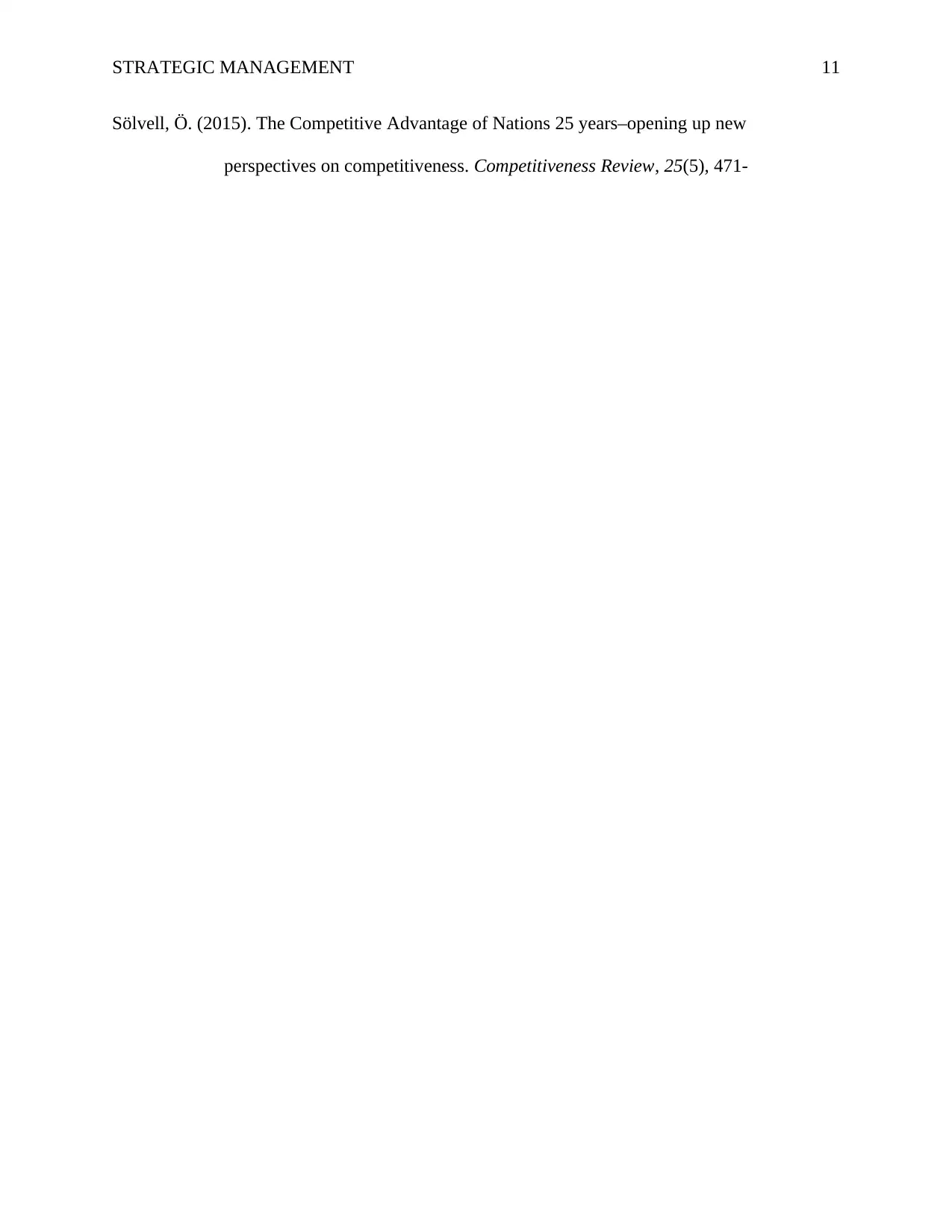
STRATEGIC MANAGEMENT 11
Sölvell, Ö. (2015). The Competitive Advantage of Nations 25 years–opening up new
perspectives on competitiveness. Competitiveness Review, 25(5), 471-
Sölvell, Ö. (2015). The Competitive Advantage of Nations 25 years–opening up new
perspectives on competitiveness. Competitiveness Review, 25(5), 471-
1 out of 11
Related Documents
Your All-in-One AI-Powered Toolkit for Academic Success.
+13062052269
info@desklib.com
Available 24*7 on WhatsApp / Email
![[object Object]](/_next/static/media/star-bottom.7253800d.svg)
Unlock your academic potential
Copyright © 2020–2025 A2Z Services. All Rights Reserved. Developed and managed by ZUCOL.




